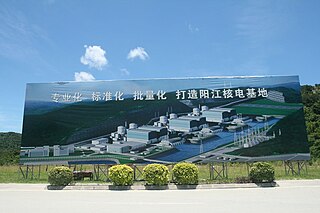Related Research Articles

The AP1000 is a nuclear power plant designed and sold by Westinghouse Electric Company. The plant is a pressurized water reactor with improved use of passive nuclear safety and many design features intended to lower its capital cost and improve its economics.
The Karachi Nuclear Power Plant is a large commercial nuclear power plant located at the Paradise Point in Karachi, Sindh, Pakistan.

The China National Nuclear Corporation is a state-owned enterprise founded in 1955 in Beijing. CNNC's president and vice-president are appointed by the Premier of the People's Republic of China. CNNC oversees all aspects of China's civilian and military nuclear programs. According to its own mission statement, it "is a main part of the national nuclear technology industry and a leading element of national strategic nuclear forces and nuclear energy development." CNNC is a nationwide industrial conglomerate integrating science, technology, industry, and international trade.
The Chashma Nuclear Power Plant is a large commercial nuclear power plant located at Chashma in Mianwali, Punjab, Pakistan.
As of 2022, nuclear power is provided by six commercial nuclear power plants in Pakistan. Pakistan is the first Muslim majority country in the world to construct and operate civil nuclear power plants. The Pakistan Atomic Energy Commission (PAEC), the scientific and nuclear governmental agency, is solely responsible for operating these power plants. As of 2018, the electricity generated by commercial nuclear power plants constitutes roughly 7.5% of electricity generated in Pakistan, Pakistan is not a party to the Nuclear Non-Proliferation Treaty but is a member of the International Atomic Energy Agency. Pakistan plans on constructing 32 nuclear power plants by 2050 and envisions 40,000 MW of nuclear power generation.

China is one of the world's largest producers of nuclear power. The country ranks third in the world both in total nuclear power capacity installed and electricity generated, accounting for around one tenth of global nuclear power generated. As of February 2023, China has 55 plants with 57GW in operation, 22 under construction with 24 GW and more than 70 planned with 88GW. About 5% of electricity in the country is due to nuclear energy. These plants generated 417 TWh of electricity in 2022 This is versus the September 2022 numbers of 53 nuclear reactors, with a total capacity of 55.6 gigawatt (GW). In 2019, nuclear power had contributed 4.9% of the total Chinese electricity production, with 348.1 TWh.

Tianwan Nuclear Power Plant is a nuclear power plant (NPP) in the city of Lianyungang in Jiangsu Province, China. It is located on the coast of the Yellow Sea approximately 30 kilometers east of downtown Lianyungang. It is owned by Jiangsu Nuclear Power Corporation, a joint venture mainly owned by the China National Nuclear Power Co., Ltd (CNNP),subsidiary of China National Nuclear Corporation (CNNC).
The Hongyanhe Nuclear Power Plant (红沿河核电站) is located in Donggang Town, Wafangdian in Liaoning Province of China. The site is within the Prefecture-level city of Dalian, 104 kilometres (65 mi) north of Dalian City proper. The first unit started commercial operations in June 2013.
The MKER is a Russian third generation nuclear reactor design. It was a development of the RBMK nuclear power reactor. No reactor of such MKER type will continue to be developed, as ROSATOM have shelved the design.
Fangjiashan Nuclear Power Plant (方家山核电站) is a nuclear power plant in the Zhejiang province, China, bordering the Shanghai municipality. The plant consists of two 1,080 MW CPR-1000 pressurized water reactors (PWR) at a total cost of estimated 26 billion yuan.
China General Nuclear Power Group (CGN), formerly China Guangdong Nuclear Power Group (中国广东核电集团), is a Chinese state-owned energy corporation under the SASAC of the State Council.
The Fuqing Nuclear Power Plant is a nuclear power plant in Fuqing, Fujian Province, China. The plant is located on the coast of Xinghua Bay, near Qianxue Village, Sanshan Town. The station has four 1,089 megawatt (MW) CPR-1000 pressurized water reactors (PWRs). The CPR-1000 is an advanced PWR design developed by China from the Areva-designed PWRs at the Daya Bay Nuclear Power Plant. The plant was jointly constructed and is operated by China National Nuclear Corporation (51%), China Huadian Corp. (39%) and the Fujian Investment & Development Co Ltd. (10%).
Changjiang Nuclear Power Plant is a nuclear power plant in Tangxing Village of Haiwei Township, Changjiang Li Autonomous County in the province of Hainan. It is the first power plant of its kind in the province.

The Yangjiang Nuclear Power Station is a nuclear power plant in Guangdong province, China. The site is Dongping Town, Yangjiang City in western Guangdong Province. The station has six 1,000 megawatt (MW) CPR-1000 pressurized water reactors (PWRs). The plant began commercial operation in March 2014, and as of 2019 is the largest nuclear power station in China.
The CPR-1000, or CPR1000 is a Generation II+ pressurized water reactor, based on the French 900 MWe three cooling loop design (M310) imported in the 1980s, improved to have a slightly increased net power output of 1,000 MWe and a 60-year design life.

The Hualong One is a Chinese Generation III pressurized water nuclear reactor jointly developed by the China General Nuclear Power Group (CGN) and the China National Nuclear Corporation (CNNC). The CGN version, and its derived export version, is called HPR1000. It is commonly mistakenly referred to in media as the "ACPR1000" and "ACP1000", which are in fact earlier reactors design programs by CGN and CNNC.
The CNP-600 is a pressurized water nuclear reactor developed by the China National Nuclear Corporation (CNNC).
The CFR-600 is a sodium-cooled pool-type fast-neutron nuclear reactor under construction in Xiapu County, Fujian province, China, on Changbiao Island. It is a generation IV demonstration project by the China National Nuclear Corporation (CNNC). The project is also known as Xiapu fast reactor pilot project. Construction of the reactor started in late 2017. These reactors are expected to be connected to the grid in 2023 and 2025. The reactor will have an output of 1500 MWth thermal power and 600 MW electric power. The fuel will be supplied by TVEL, subsidiary of Rosatom, according to the agreement signed in 2019.
The CNP-300 is a pressurized water nuclear reactor developed by the China National Nuclear Corporation (CNNC).
References
- 1 2 "Chinese reactor design evolution - Nuclear Engineering International". www.neimagazine.com. Retrieved 28 May 2018.
- 1 2 Biello, David (29 March 2011). "China forges ahead with nuclear energy". Nature. doi:10.1038/news.2011.194 . Retrieved 28 May 2018.
- ↑ "Status of Small and Medium Sized Reactor Designs" (PDF). International Atomic Energy Agency. September 2011. Retrieved 28 May 2018.
- ↑ "UxC: SMR Design Profile". www.uxc.com. Retrieved 29 May 2018.
- ↑ "China's commercial reactors" (PDF). Nuclear Engineering International. Retrieved 29 May 2018.
- ↑ (IAEA), International Atomic Energy Agency. "- Nuclear Power - IAEA". www.iaea.org. Retrieved 29 May 2018.
- 1 2 3 4 5 "Chinese reactor design evolution - Nuclear Engineering International".
- ↑ Wang Yanjun; et al. (22 May 2013). "I&C application status in NPPs in China" (PDF). China Nuclear Power Engineering Co. Archived (PDF) from the original on 12 October 2013. Retrieved 11 October 2013.
- ↑ "Nuclear Power in China". World Nuclear Association. 24 September 2013. Archived from the original on 3 November 2013. Retrieved 30 September 2013.
- ↑ "CGN Chairman He Yu Makes Proposal for Promoting Export of China-designed Nuclear Power Technology ACC1000". CGN. 6 March 2014. Archived from the original on 8 April 2014. Retrieved 7 April 2014.
- ↑ "Nuclear Power in China". World Nuclear Association. April 2014. Archived from the original on 3 November 2013. Retrieved 7 April 2014.
- ↑ Caroline Peachey (22 May 2014). "Chinese reactor design evolution". Nuclear Engineering International. Archived from the original on 28 December 2019. Retrieved 23 May 2014.
- ↑ "China's new nuclear baby". World Nuclear News. 2 September 2014. Archived from the original on 8 September 2019. Retrieved 9 March 2015.
- ↑ "Independent Gen-III Hualong-1 reactor technology passes national review". CGN. 22 August 2014. Archived from the original on 2 April 2015. Retrieved 9 March 2015.